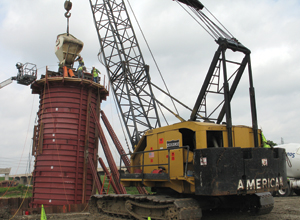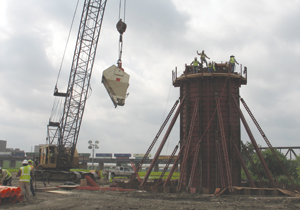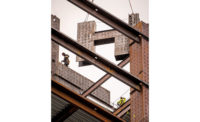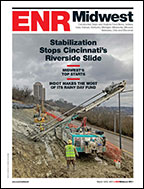

Soil concerns While drilling the support piers, crews hit sand, and one of the excavation areas started caving in, Dugger says. Crews added a casing to the pier. The U.S. Army Corps of Engineers then asked the city of Dallas to perform more soil borings, which was done. In addition, the corps found the levees unacceptable during a periodic inspection, so the federal agency requested further geotechnical borings to identify the soil characteristics and determine if there are seepage or stability issues affecting the levees.
“If those characteristics show there are problems, they will have to identify some solutions to ensure construction of the bridge does not have long-term adverse impact on the levee system,” says Kevin Craig, acting director of the Trinity River Project for the corps.
Dugger says that remediation could include a slurry wall.
Craig says the corps has no reason to believe the bridge would be structurally affected by the sandy conditions. He says its concerns are related to putting piers into the levees.
“We have to ensure that doesn’t lead to a shorter seepage path for water to get under the levees and potentially erode them,” Craig says.
TxDOT’s geotechnical consultant began working on the evaluation at the end of June. The agency gave Kleinfelder of Fort Worth 3.5 months to take soil borings and produce a seepage analysis.
Hartzel says TxDOT has not set a schedule for submitting the investigation’s results to the corps. Until the issues are resolved, contractors must avoid any construction activity within 50 ft of the toe of the levees.
“Bridge construction is ongoing, except in an area just above the levee template,” Craig says. “They can put up their steel and deck everywhere except right there at the levee.”
Current activity Neither Williams Bros. nor Abrams returned requests forinformation about the project. Williams Bros. is working its way across the river, Dugger says. Crews poured the identical arch span columns during all-day pours in April and May. The company has started working on temporary shoring, Hartzel says.
Meanwhile, Abrams is setting beams over Interstate 35 on the east side of the levee. Approaches on the west side fall into the 50-ft construction-free zone, waiting geotechnical results.
Steel spans, fabricated by Cimolai Costruzioni Metalliche in Italy, have started to arrive and on-site welding was expected to commence in August .
“We’re still making a lot of progress on the bridge,” Hartzel says. “There will be a couple of bents and decks we cannot do until we have clearance from the corps.”



Post a comment to this article
Report Abusive Comment